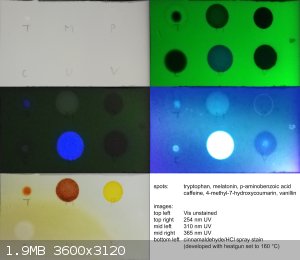Cinnamaldehyde/HCl as TLC spray stain for indoles
I came across this interesting reagent as an alternative to Ehrlich's reagent for the detection of indoles on TLC. Please note the general precautions
for spray stains (working in a fume hood to avoid exposure to the aerosol). I highly recommend getting an all-glass TLC sprayer, as the produced mist
is considerably finer than a pump-spray bottle and can handle way more aggressive reagents.
Spray stain: 5 mL cinnamaldehyde + 95 mL ethanol + 5 mL of 36% HClaq.. (Variants include just spraying with the cinnamaldehyde and then
placing in a chamber full of HCl vapors, but this here was easier to do. Also, I needed some mild heat from a heatgun to delevop the stain.)
Note that per plate only 1 - 2 mL of stain are needed, and that the stain isn't stable in storage, so it's best freshly made just before use in the
needed amount.

(Excuse the somewhat uneven staining in the lower left corner of the plate.)
The source is E. Stahl, Thin-Layer Chromatography - A Laboratory Handbook, 2nd edition 1969 (translated by M. R. F.
Ashworth), p. 864, ISBN 978-3-642-88488-7.
This book is highly recommended.
To test the stain, six samples were spotted onto a TLC plate: tryptophan, melatonin, p-aminobenzoic acid, caffeine, 7-hydroxy-4-methylcoumarine and
vanillin.
My stain used commercial cinnamon essential oil. The stain was sprayed onto the plate with a glass TLC sprayer. p-Aminobenzoic acid and melatonin
quickly changed color. The plate was then dried and gently heated with a heatgun set to 160 °C. Dark orange spots developed for tryptophan and
melatonin. p-Aminobenzoic acid turns an orange-yellow.

Note that the spot for tryptophan is rather small, this is due to the low Rf in the spotting solvent, MeOH. (What is causing the fluorescence in that
spot is unknown to me, it was sold as a food supplement, and it is not the tryptophan itself either.)
I have also tested this on actual developed TLC plates, but they looked no different to these tests.
So in conclusion it works and this may be a more OTC alternative to Ehrlich's reagent, but always keep in mind that the stain also seems to visualize
aryl amines (hardly surprising due to the formation of a schiff base - I would expect Ehrlich's reagent to do the same). It's proabably also less
sensitive than Ehrlich's reagent, but I haven't tested it, and the stains still seems sensitive enough.
we apologize for the inconvenience
|